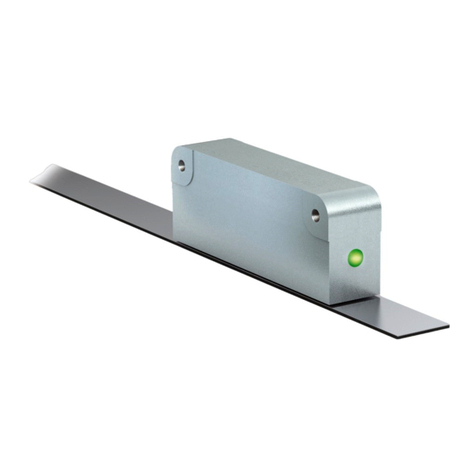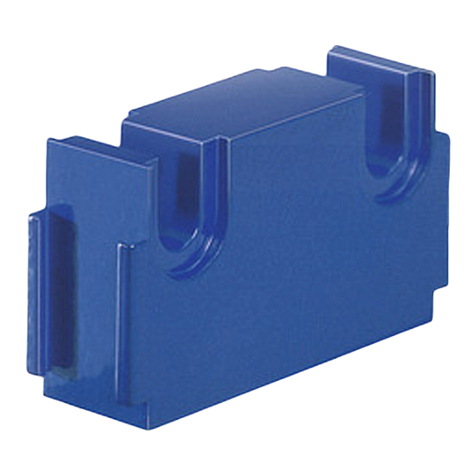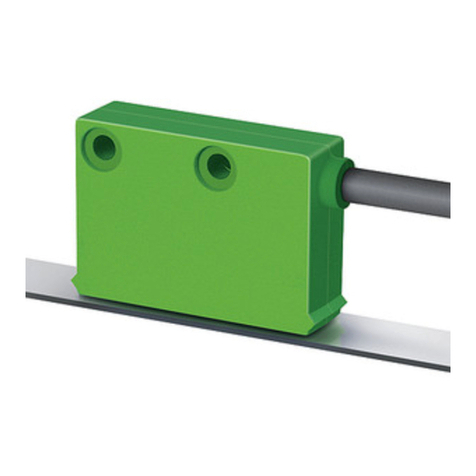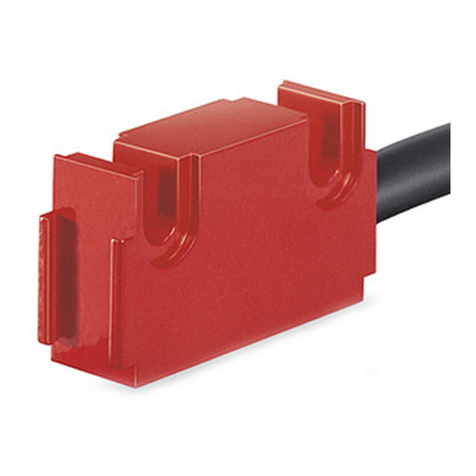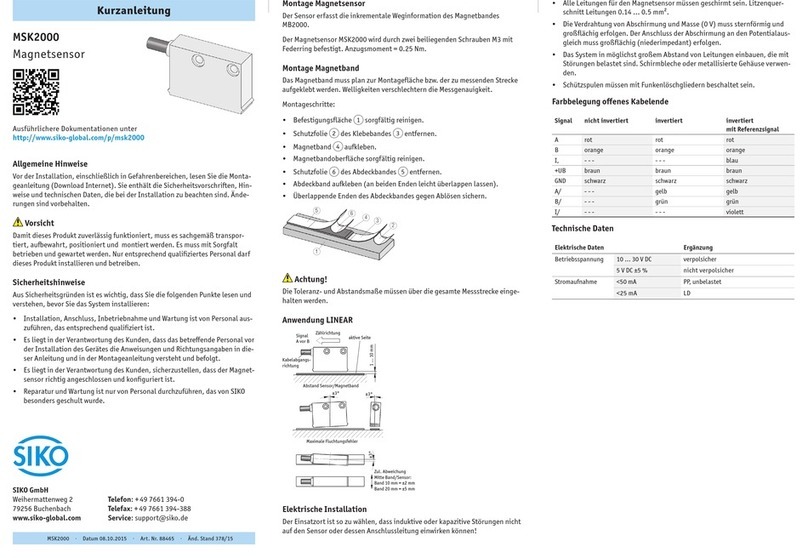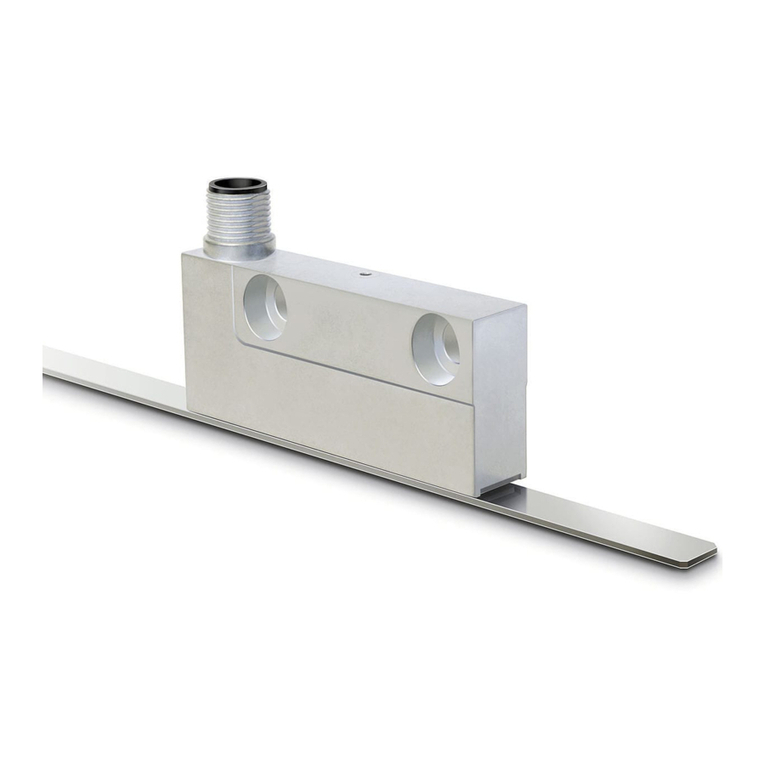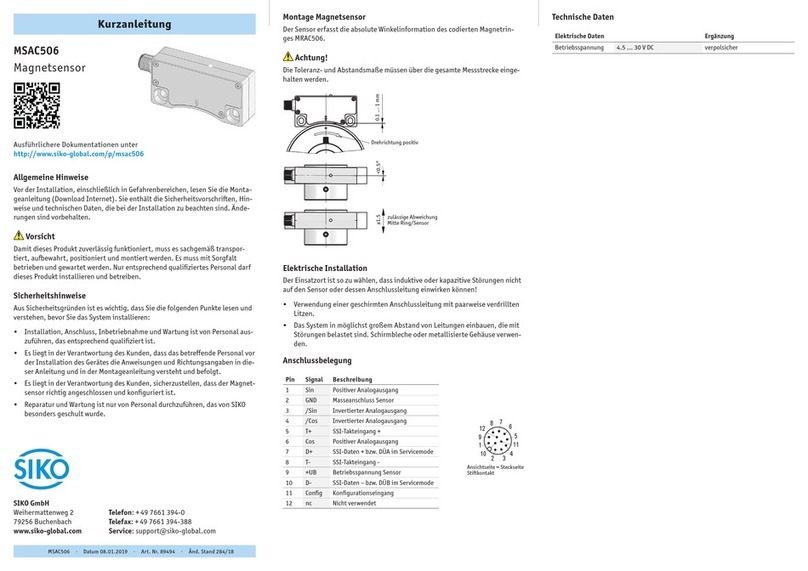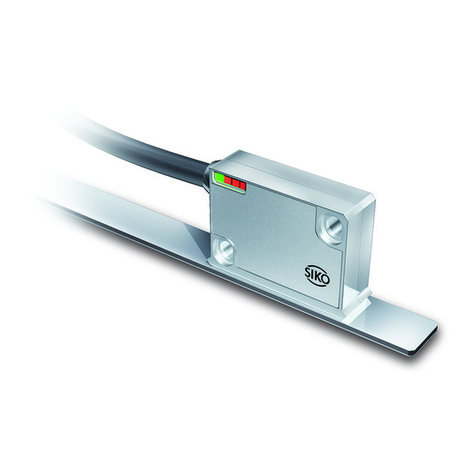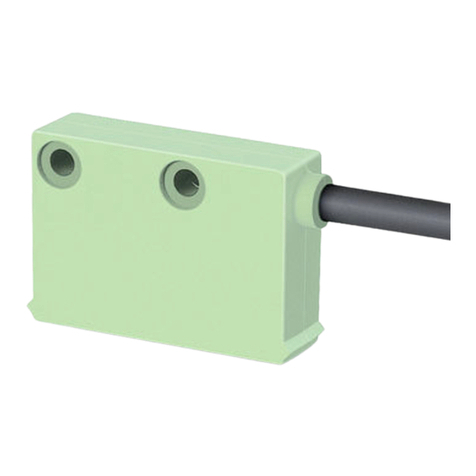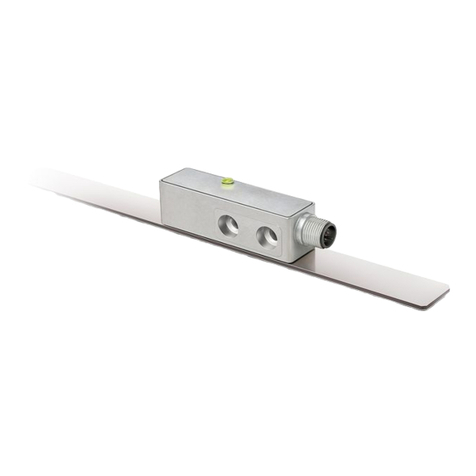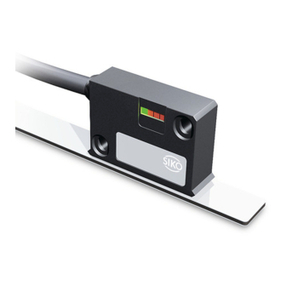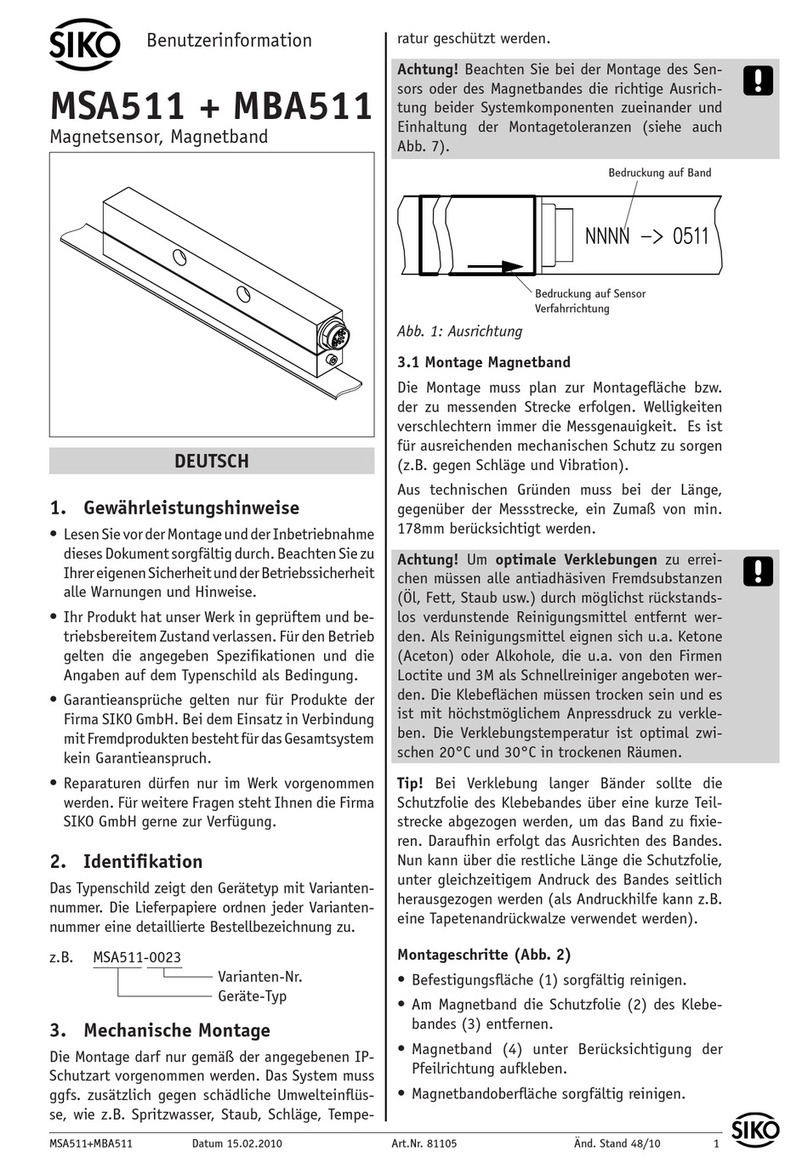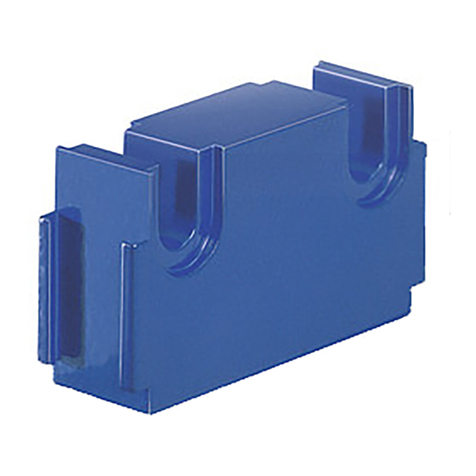Siko MSK500/1 Operation manual

MSK500/1+MB500+MR500 Datum 02.09.2010 Art.Nr. 81413 Änd. Stand 292/10 1
MR500
MSK500/1
MB500
DEUTSCH
Sensordarstellungen sind exemplarisch und gültig
für alle Bauformen, sofern nicht gesondert be-
schrieben.
1. Gewährleistungshinweise
Lesen Sie vor der Montage und der Inbetriebnahme
dieses Dokument sorgfältig durch. Beachten Sie zu
Ihrer eigenen Sicherheit und der Betriebssicherheit
alle Warnungen und Hinweise.
Ihr Produkt hat unser Werk in geprüftem und be-
triebsbereitem Zustand verlassen. Für den Betrieb
gelten die angegeben Spezifikationen und die
Angaben auf dem Typenschild als Bedingung.
Garantieansprüche gelten nur für Produkte der
Firma SIKO GmbH. Bei dem Einsatz in Verbindung
mit Fremdprodukten besteht für das Gesamtsystem
kein Garantieanspruch.
Reparaturen dürfen nur im Werk vorgenommen
werden. Für weitere Fragen steht Ihnen die Firma
SIKO GmbH gerne zur Verfügung.
2. Identifikation
Magnetband: Das Magnetband ist durch eine fort-
laufende Bedruckung identifizierbar.
•
•
•
•
Magnetsensor: Das Typenschild zeigt den Ge-
rätetyp mit Variantennummer. Die Lieferpapiere
ordnen jeder Variantennummer eine detaillierte
Bestellbezeichnung zu.
z.B. MSK500/1-0023
Varianten-Nr.
Geräte-Typ
3. Mechanische Montage
Die Montage darf nur gemäß der angegebenen IP-
Schutzart vorgenommen werden. Das System muss
ggfs. zusätzlich gegen schädliche Umwelteinflüs-
se, wie z.B. Spritzwasser, Lösungsmittel, Staub,
Schläge, Vibrationen, starke Temperaturschwan-
kungen geschützt werden.
3.1 Montage Magnetband
Die Montage muss plan zur Montagefläche bzw. der
zu messenden Strecke erfolgen. Welligkeiten ver-
schlechtern immer die Messgenauigkeit.
Überall wo aufgrund unzureichender Befestigungsmöglichkeiten
keine geeignete Montage des Magnetbandes möglich ist, kann das
Magnetband in eine als Zubehör lieferbare Profilschiene (z.B. Typ
PS oder PS1) montiert werden. Dadurch entsteht eine kompakte
Magnetbandeinheit.
Aus technischen Gründen muss bei der Länge, ge-
genüber der Messstrecke, ein Zumaß von 100mm
berücksichtigt werden.
Achtung! Um optimale Verklebungen zu errei-
chen müssen alle antiadhäsiven Fremdsubstanzen
(Öl, Fett, Staub usw.) durch möglichst rückstands-
los verdunstende Reinigungsmittel entfernt wer-
den. Als Reinigungsmittel eignen sich u.a. Ketone
(Aceton) oder Alkohole, die u.a. von den Firmen
Loctite und 3M als Schnellreiniger angeboten wer-
den. Die Klebeflächen müssen trocken sein und es
ist mit höchstmöglichem Anpreßdruck zu verkle-
ben. Die Verklebungstemperatur ist optimal zwi-
schen 20°C und 30°C in trockenen Räumen.
Tip! Bei Verklebung langer Bänder sollte die
Schutzfolie des Klebebandes über eine kurze Teil-
strecke abgezogen werden, um das Band zu fixie-
ren. Daraufhin erfolgt das Ausrichten des Bandes.
Nun kann über die restliche Länge die Schutzfolie,
unter gleichzeitigem Andruck des Bandes, seitlich
herausgezogen werden (als Hilfsmittel kann eine
Tapetenandrückwalze verwendet werden).
Montageschritte (Abb. 1)
Befestigungsfläche (1) sorgfältig reinigen.
Am Magnetband die Schutzfolie (2) des Klebe-
bandes (3) entfernen.
Magnetband (4) aufkleben.
•
•
•
Benutzerinformation
MSK500/1 Magnetsensor
MB500 Magnetband
MR500 Magnetring
Chargennummer
Referenzpunkt
Werkstoff-Trägerband
Genauigkeit
MB Typ
MBxxxx GEK WT RP NNNNNN

2 MSK500/1+MB500+MR500 Datum 02.09.2010 Art.Nr. 81413 Änd. Stand 292/10
Abb. 1: Montage Magnetband
Abb. 2 Abb. 3
Abb. 4 Abb. 5
Verfahrrichtung
Signal A vor B aktive Seite
0.1mm ... 2.0mm
ohne Referenzpunkt
0.1mm ... 1.5mm
mit Referenzpunkt
Kabelabgangs-
richtung
Abstand Sensor/Magnetband
<1° <3°
<3°
maximale Fluchtungsfehler
Zul. Abweichung
Mitte Band/Sensor:
ohne Ref. ±2mm
mit Ref. ±0.5mm
Referenzpunktlage zur Magnetband-
bedruckung
MBxxxx GEK WT RP NNNNNN
Achtung! Die Beeinflussung durch magnetische
Felder ist zu vermeiden. Insbesondere dürfen keine
Magnetfelder (z.B. Haftmagnete oder andere Dau-
ermagnete) in direkten Kontakt mit dem Magnet-
band geraten. In stromlosem Zustand werden Be-
wegungen oder Verstellungen des Magnetsensors
von der Folgeelektronik nicht erkannt und erfasst.
Montagebeispiele
Die einfache Montageart, durch angeschrägtes
Schutzband (Abb. 2), ist nur in sehr geschützter
Umgebung zu empfehlen. Bei ungeschützer Um-
gebung besteht Abschälgefahr. In solchen Fällen
sind Montagearten, wie in Abb. 3 und 4 gezeigt,
geeigneter.
Den optimalen Schutz bietet die Montage in ei-
ner Nut (Abb. 5), die so tief sein sollte, dass das
Magnetband vollständig darin eingebettet werden
kann.
Der Magnetring MR500 muss möglichst kraft-
und spannungsfrei montiert werden. Eventuell
erforderliche Belastungen sind am Metallflansch
aufzubringen. Schläge auf den Magnetring sind
zu vermeiden.
Ein Wellenfreistich entsprechend Abb. 7 wird
empfohlen.
3.3 Montage Magnetsensor MSK500/1
Der Magnetsensor MSK500/1 kann durch Verwen-
dung von 2 Schrauben M3 über die ø3,5mm Durch-
gangslöcher befestigt werden. Es wird empfohlen
die beiliegenden Befestigungsschrauben und Fe-
derringe zu verwenden (Anzugsmoment 0,25Nm).
Kabel sind so zu verlegen, dass keine Beschä-
digungsgefahr besteht. Zugentlastung und
wenn nötig Schleppkette oder Schutzschlauch
vorsehen.
Auf richtige Ausrichtung bezüglich der Zähl-
richtung achten (Abb. 6+7). Dies ist unerheblich
falls sich die Zählrichtung in der elektronischen
Auswertung umkehren läßt (wie z.B. bei den
Magnetbandanzeigen von SIKO).
Achtung! Die Toleranz- und Abstandsmaße müs-
sen über die gesamte Messstrecke eingehalten
werden.
Anwendung LINEAR MSK500/1 mit MB500:
•
•
•
•
3.2 Montage Magnetring MR500
Nach dem Aufschieben des Magnetringes auf die
Welle, wird durch Anziehen des Gewindestiftes M6
der MR500 mit der Welle verbunden.
Zwischen Welle und dem MR500 ist ein Schiebesitz
vorzusehen.
•
Magnetbandoberfläche sorgfältig reinigen.
Am Abdeckband (5) die Schutzfolie (6) des Kle-
bebandes entfernen.
Abdeckband aufkleben (an beiden Enden leicht
überlappen lassen).
Die überlappenden Enden des Abdeckbandes gegen
Ablösen sichern.
•
•
•
•

MSK500/1+MB500+MR500 Datum 02.09.2010 Art.Nr. 81413 Änd. Stand 292/10 3
Abb. 6: Definition der Zählrichtung mit Magnetband
und Montage Sensor/Magnetband, Abstandsmaße,
Toleranzen
Referenzpunkt periodisch
Lage Ref.Punkt R=entspr. Lieferpapiere
Symbolische Dar-
stellung der Pole Einmaliger Referenzpunkt
Lage Ref.Punkt E=entspr. Lieferpapiere
min. 0,05m
Abb. 7: Definition der Zählrichtung mit Magnetring
und Montage Sensor / Magnetring, Abstandsmaße,
Toleranzen
Kabelabgangsrichtung
0.1mm ... 2.0mm ohne Referenzpunkt
0.1mm ... 1.5mm mit Referenzpunkt
<3°
Signal
A vor B
Freistich an
der Vollwelle
für Gewin-
destift wird
empfohlen
Referenz-
punkt
Drehrichtung Magnetring
Zul. Abweichung
Mitte Band/Sensor:
ohne Ref. ±2mm
mit Ref. ±0.5mm
<3°
Anwendung RADIAL MSK500/1 mit MR500:
und Verdrahtung können Störeinflüsse (z.B.von
Schaltnetzteilen, Motoren, getakteten Reglern
oder Schützen) vermindert werden.
Erforderliche Maßnahmen
Nur geschirmtes Kabel verwenden. Den Kabel-
schirm beidseitig auflegen. Litzenquerschnitt der
Leitungen min. 0,14mm²; max. 0,5mm².
Die Verdrahtung von Abschirmung und Masse
(0V) muss sternförmig und großflächig erfolgen.
Der Anschluss der Abschirmung an den Potenti-
alausgleich muss großflächig (niederimpedant)
erfolgen.
Das System muss in möglichst großem Abstand von
Leitungen eingebaut werden, die mit Störungen
belastet sind; ggfs. sind zusätzliche Maßnahmen
wie Schirmbleche oder metallisierte Gehäuse
vorzusehen. Leitungsführungen parallel zu Ener-
gieleitungen vermeiden.
Schützspulen müssen mit Funkenlöschgliedern
beschaltet sein.
Spannungsversorgung
Die Spannungswerte sind abhängig von der Sen-
sorausführung und sind den Lieferpapieren sowie
dem Typenschild zu entnehmen.
z.B.: 24 VDC ±20%
Achtung! Die maximale Länge des Anschlusskabels
zwischen Sensor und Nachfolgeelektronik beach-
ten.
Hinweis: Bei Betriebsspannung 24VDC und Aus-
gangsschaltung LD sind, um thermische Überlas-
tung zu vermeiden, Abschlusswiderstände ≥470
Ohm zu verwenden.
Hinweis: Bei Index-/Referenzsignalbreite von 4
Inkrementen (= 360°), ist der Index/Referenz erst
nach dem 5. Zählschritt (Inkrement) auswertbar.
Nach dem Einschalten der Betriebsspannung ent-
sprechende Verzögerung berücksichtigen.
4.1 Anschlusshinweis nach RS422 Norm
Es ist darauf zu achten, dass die Kanäle mit einem
Abschlusswiderstand von 120 Ohm abgeschlossen
werden.
•
•
•
•
4. Elektrischer Anschluss
Verdrahtungsarbeiten dürfen nur spannungslos
erfolgen!
Vor dem Einschalten sind alle Leitungsanschlüsse
und Steckverbindungen zu überprüfen.
Hinweise zur Störsicherheit
Alle Anschlüsse sind gegen äußere Störeinflüsse
geschützt. Der Einsatzort ist aber so zu wählen,
dass induktive oder kapazitive Störungen nicht
auf den Sensor oder dessen Anschlussleitung
einwirken können! Durch geeignete Kabelführung
•
•

4 MSK500/1+MB500+MR500 Datum 02.09.2010 Art.Nr. 81413 Änd. Stand 292/10
so kurz wie
möglich
Schirm
Abb. 8: Anschluss E1
Ansichtseite =
Steckseite
Stiftkontakt
Ansichtseite =
Steckseite
Stiftkontakt
Abb. 9: Montage Anschlussart E6
Schirm
Buchsenteil
Stiftteil
Schirm
E6: Anschluss mit Stiftkontakt und Buchsenkon-
takt. Steckermontage entsprechend Abb. 9.
Signal invertiert invertiert mit
Referenzsignal
A Pin 1 Pin 1
B 2 2
I, R - - - 3
+UB 4 4
GND 5 5
A/ 6 6
Signal invertiert invertiert mit
Referenzsignal
B/ 7 7
I/, R/ - - - 8
- - - 3 - - -
Pos. 6 ... 10 über Kabelmantel schieben.
Kabel abisolieren.
Schirm umlegen.
Pos. 5 auf Litzen schieben.
Litzen an Pos. 3 löten (entspr. Anschlussplan).
Abstandhülse Pos. 4 aufweiten und über Litzen
stülpen, zusammendrücken und auf Pos. 3 ste-
cken. Schlitz und Nut (Pos. 3 und 4) müssen
deckungsgleich sein.
Pos. 6 an Pos. 5 drücken, überstehenden Schirm
abschneiden.
Pos. 2 und 7 aufschieben und mittels Montage-
werkzeug Pos. 11 verschrauben.
Pos. 8 in Pos. 9 stecken, beides in Pos. 7
schieben.
Pos. 10 mit Pos. 7 verschrauben.
Pos. 1 in Pos. 2 schieben.
1.
2.
3.
4.
5.
6.
7.
8.
9.
10.
11.
4.2 Anschlussarten / Anschlussbelegung
E1: Anschluss mit offenen Kabelenden.
Achtung! Verzinnte Litzen dürfen nicht in Verbin-
dung mit Schraubklemmverbindungen eingesetzt
werden.
Signal invertiert invertiert mit
Referenzsignal
A rot rot
B orange orange
I, R - - - blau
+UB braun braun
GND schwarz schwarz
A/ gelb gelb
B/ grün grün
I/, R/ - - - violett
Ummantelung entfernen.
Schirm auftrennen und verdrillen.
Litzen ca. 5mm abisolieren und verdrillen.
Aderendhülsen aufquetschen.
1.
2.
3.
4.
E7: Anschluss mit 8-pol. Kupplungsstecker.
Signal invertiert invertiert mit
Referenzsignal
A Pin 1 Pin 1
B 2 2
I, R - - - 3
+UB 4 4
GND 5 5
A/ 6 6
B/ 7 7
I/, R/ - - - 8
- - - 3, 8 - - -

MSK500/1+MB500+MR500 Datum 02.09.2010 Art.Nr. 81413 Änd. Stand 292/10 5
Ansichtseite = Steckseite
Stiftkontakt
Ansichtseite = Steckseite
Stiftkontakt
Abb. 10: Ermittlung der Polarität. Trennung des
Magnetbandes.
Abb. 11: Ermittlung der Polarität. Ansetzen des
Magnetbandes.
E8: Anschluss mit 9-pol. D-SUB Stiftkontakt und
Buchsenkontakt.
Vorgehensweise
Falls ein Abdeckband vorhanden ist, muss dieses
zuerst entfernt werden.
Polteilung durch Bestreuen des Magnetbandes
mit Metallstaub oder mit Hilfe einer Magnetlupe
oder Magnetfolie ermitteln.
Wenn erforderlich mit Kompaßnadel kontrollie-
ren, wo sich die Pole am Magnetband befinden
(Abb. 10).
Lineal anlegen und Magnetband mit scharfem
Messer rechtwinklig abtrennen. Anschließend
auch Trägerband entsprechend kürzen.
Vorherige Schritte am anzusetzenden Band
wiederholen.
Vor dem Ansetzen die Polarität überprüfen.
Die beiden Enden müssen sich anziehen (ggfs.
Kompaßnadel benutzen). Falls gleiche Polarität,
ein Band um einen halben Polabstand kürzen
(Abb. 11).
Beide Bänder stoßend montieren und Abdeckband
aufkleben.
6. Wartung
Die Oberfläche des Magnetbandes ist bei starker
Verschmutzung durch Staub, Späne, Feuchtigkeit
usw., von Zeit zu Zeit mit einem weichen Lappen
zu reinigen.
7. Fehlerbehandlung
Typische Fehler, die bei Anbau und Betrieb auf-
treten:
Das Magnetband wurde falsch montiert / aktive
Seite nach unten (siehe Kapitel 3.1).
•
•
•
•
•
•
•
•
Signal invertiert invertiert mit
Referenzsignal
A Pin 1 Pin 1
B 2 2
I, R - - - 3
+UB 4 4
GND 5 5
A/ 6 6
B/ 7 7
I/, R/ - - - 8
- - - 3, 8, 9 9
E8E: Anschluss mit 9-pol. D-SUB Stecker.
Signal invertiert mit
Referenzsignal
- - - PIN 1
I/, R/ 2
B/ 3
A 4
GND 5
+UB 6
I, R 7
B 8
A/ 9
5. Verlängern von Magnetbändern
Manche Anwendungsfälle können die Verlängerung
des Magnetbandes erfordern. Mit einfachen Hilfs-
mitteln besteht die Möglichkeit das Magnetband
zu trennen und wieder zusammenzusetzen.
Es ist jedoch selbst bei exakter Vorgehenswei-
se damit zu rechnen, dass die Genauigkeit an
der Trennstelle beeinträchtigt wird (Fehler min.
0,1mm ... 0,2mm).
Hilfsmittel
Magnetlupe, -folie oder Metallstaub
Lineal oder geeignetes Werkzeug
Kompaßnadel
•
•
•

6 MSK500/1+MB500+MR500 Datum 02.09.2010 Art.Nr. 81413 Änd. Stand 292/10
Zum Schutz des Magnetbandes wurde nicht das
mitgelieferte Abdeckband verwendet. Das Abdeck-
band muss nicht magnetisierbar sein.
Der Sensor ist nicht, oder nicht korrekt ange-
schlossen (Pinbelegung Kapitel 4.2).
Die Abstandstoleranz zwischen Sensor und Ma-
gnetband/Magnetring wurde nicht eingehalten
(beim Band über die gesamte Messstrecke!), der
Sensor streift auf dem Magnetrin (Abb. 6+7).
Kabelunterbrechung / Abtrennung durch scharfe
Kanten / Quetschung.
Der Sensor ist mit der aktiven Seite vom Band
abgewandt montiert (Abb. 6+7).
Der Sensor wurde nicht entsprechend Abb. 6+7
ausgerichtet.
•
•
•
•
•
•

MSK500/1+MB500+MR500 Datum 02.09.2010 Art.Nr. 81413 Änd. Stand 292/10 7
batch number
reference point
carrier strip
accuracy
MB type
MBxxxx GEK WT RP NNNNNN
MR500
MSK500/1
MB500
ENGLISH
Exemplary sensor illustrations are valid for all sen-
sor types unless described separately.
1. Warranty information
In order to carry out installation correctly, we
strongly recommend this document is read very
carefully. This will ensure your own safety and
the operating reliability of the device.
Your device has been quality controlled, tested
and is ready for use. Please observe all warnings
and information which are marked either directly
on the device or specified in this document.
Warranty can only be claimed for components
supplied by SIKO GmbH. If the system is used
together with other products, there is no warranty
for the complete system.
Repairs should be carried out only at our works.
If any information is missing or unclear, please
contact the SIKO sales staff.
2. Identification
Magnetic strip: identification by printing on the
strip.
•
•
•
•
Magnetic sensor: Please check the particular type
of unit and type number from the identification
plate. Type number and the corresponding version
are indicated in the delivery documentation.
e.g. MSK500/1-0023
version number
type of unit
3. Installation
For mounting, the degree of protection specified
must be observed. If necessary, protect the unit
against environmental influences such as sprayed
water, dust, knocks, extreme temperatures.
3.1 Mounting the magnetic strip
The mounting surface / measuring track must be
flat. Buckles or bumps will lead to measuring in-
accuracies.
For applications which do not allow properly glueing of the magne-
tic strip, it can be inserted into a profile rail (accessory) - e.g. rail
type PS or PS1 thus forming a compact mounting unit.
For technical reasons the strip should be approx.
100mm longer than the actual measuring dis-
tance.
Attention! To guarantee optimal adhesion oil,
grease dust etc. must be removed by using clean-
sing agents which evaporate without leaving re-
sidues. Suitable cleansing agents are eg. ketones
(acetone) or alcohols; Messrs. Loctite and 3M can
both supply such cleansing liquid. Make sure that
the surface to be glued is dry and apply the strip
with maximum pressure. Glueing should preferably
be undertaken at temperatures between 20°C to
30°C and in dry atmosphere.
Advice! When applying long pieces of magnetic
strip do not immediately remove the complete
protective foil, but rather peel back a short part
from the end sufficient to fix the strip. Now align
the strip. As the protective strip is then peeled
back and out press the tape firmly onto the moun-
ting surface. A wall paper roller wheel could be
used to assist in applying pressure onto the mag-
netic strip when fixing it in position.
Mounting steps (see fig. 1)
Clean mounting surface (1) carefully.
Remove protective foil (2) from the adhesive
side of the magnetic strip (3).
Stick down the magnetic strip (4).
Clean surface of magnetic strip carefully.
Remove protective foil (6) from adhesive tape on
the cover strip (5).
•
•
•
•
•
User Information
MSK500/1 Mangetic sensor
MB500 Mangetic strip
MR500 Mangetic ring

8 MSK500/1+MB500+MR500 Datum 02.09.2010 Art.Nr. 81413 Änd. Stand 292/10
Fig. 1: Mounting of the magnetic strip
Fig. 2 Fig. 3
Fig. 4 Fig. 5
Travel direction
Signal A before B active side
0.1mm ... 2.0mm wit-
hout reference point
0.1mm ... 1.5mm with
reference point
Direction of
outgoing cable
Gap sensor/magnetic strip
maximum alignment error
Admissable deviation
middle of tape/sensor:
without ref. point ±2mm
with ref. point ±0.5mm
Position of the reference point relating
to the marking on the magnetic strip.
<1° <3°
<3°
MBxxxx GEK WT RP NNNNNN
Fix cover strip (both ends should slightly over-
lap).
Also fix cover strip's ends to avoid unintenti-
onal peeling.
•
•
3.3 Mounting of the magnetic sensor MSK500/1
The magnetic sensor MSK500/1 can be fastened
by using two bolts M3 over the ø3,5mm through
holes. We recommend to use the enclosed fixing
screws and washer springs (fastening torque
0,25Nm).
Cables should be layed in such a way that there
is no danger of damaging. Provide tension relief
and drag chain or casing, if necessary.
Observe the correct alignment with regard
to the counting direction (fig. 6 and 7). This
does not apply if the counting direction can be
reversed in the electronic interpretation (e.g. in
SIKO's magnetic-strip displays).
Attention! The tolerance and gap measures must
be observed over the whole measuring length.
LINEAR application MSK500/1 with MB500:
•
•
Attention! Do not expose the system to magne-
tic fields. Any direct contact of the magnetic strip
with magnetic fields (e.g. adhesive magnets or
other permanent magnets) is to be avoided. Sen-
sor movements during power loss are not captured
by the follower electronics.
Mounting examples
Mounting with chamfered ends (fig. 2) is not re-
commended unless the strip is installed in a safe
and protected place without environmental influ-
ences. In less protected mounting places the strip
may peel. There we recommend mounting accord.
to fig. 3 and 4.
Mounting in a groove (fig. 5) best protects the
magnetic strip. The groove should be deep enough
to totally embed the magnetic strip.
3.2 Mounting of the magnetic ring MR500
Slide magnetic ring MR500 onto the shaft and
then tighten grub screw M6 to fix it to the shaft.
Ensure sliding fit between shaft and MR500.
Mount MR500 without force and without strain.
Possible forces should go to the metal flange.
Avoid knocks on the magnetic ring.
Provide for a relief groove in the solid shaft
(see fig. 7).
•
•
•

MSK500/1+MB500+MR500 Datum 02.09.2010 Art.Nr. 81413 Änd. Stand 292/10 9
Fig. 6: Definition of the counting direction with
magnetic strip and assemblage sensor/magnetic ring,
gap measure, tolerances
Periodical reference point
Magnetic poles
- schema Unique reference point
Position of the reference point E = as
stated in the delivery documentation
min. 0,05m
Position of the reference point R = as
stated in the delivery documentation
Fig. 7: Definition of the counting direction with
magnetic ring and assemblage sensor/magnetic ring,
gap measure, tolerances
Direction of outgoing cable
0.1mm ... 2.0mm without reference point
0.1mm ... 1.5mm with reference point
Signal
A before B
U n d e r c u t
at the solid
shaft for
tread plug is
recommen-
ded
reference
point
Direction or rotation of
magnetic ring
Admissable deviation
middle of tape/sensor:
without ref. point ±2mm
with ref. point ±0.5mm
<3°
<3°
RADIAL application MSK500/1 with MR500:
nection lines! Suitable wiring layout and choice
of cable can minimise the effects of interference
(e.g. interference caused by SMPS, motors, cyclic
controls and contactors).
Necessary measures
Only screened cable should be used. Wire cross sec-
tion is to be at least 0,14mm², max. 0,5mm².
Wiring to the screen and ground (0V) must
be secured to a good point. Ensure that the
connection of the screen and earth is made to
a large surface area with a sound connection to
minimise impedance.
The system should be positioned well away from
cables with interference; if necessary a protective
screen or metal housing must be provided. The
running of wiring parallel to the mains supply
should be avoided.
Contactor coils must be linked with spark sup-
pression.
Supply voltage
The voltages depend on the sensor designs; they
are to be taken from the delivery documentation
and the identification plate.
e.g.: 24 VDC ±20%
Attention! When connecting sensor and follower
electronics, please do not exceed the max. admis-
sable cable length.
Note: In case of operating voltage 24VDC and
output circuit LD we recommend use of terminal
resistors ≥470 Ohm in order to avoid thermic over-
load.
Note: With a 4-increment wide (= 360°) index/
reference signal, index/reference signal interpre-
tation can be made after the 5th counting step
(increment) only. Corresponding time delay has to
be considered when power is switched on.
4.1 Connection note acc. to RS422 standard
Please provide the channels with a 120 Ohm ter-
minating resistor.
•
•
•
•
4. Electrical connection
Wiring must only be carried out with power off!
Check all lines and connections before switching
on the equipment!
Interference and distortion
All connections are protected against the effects
of interference. The location should be selected
to ensure that no capacitive or inductive in-
terferences can affect the sensor or the con-
•
•

10 MSK500/1+MB500+MR500 Datum 02.09.2010 Art.Nr. 81413 Änd. Stand 292/10
as short as
possible
screening
Fig. 8: Connection type E1
viewing side =
plug-in side
plug pin
viewing side =
plug-in side
plug pin
Fig. 9: Mounting connection type E6
screening
socket
pin
screening
4.2 Connection type / Pin outs
E1: Flying leads.
Attention! Tinned strands must not used in com-
bination with screw/clamp connections.
Signal inverted inverted with
reference signal
A red red
B orange orange
I, R - - - blue
+UB brown brown
GND black black
A/ yellow yellow
B/ green green
I/, R/ - - - violet
Remove cable coating.
Open screening and twist it.
Strip stranded wires to a length of 5mm and
twist them.
Pinch stranded wires
1.
2.
3.
4.
Signal inverted inverted with
reference
signal
A/ 6 6
B/ 7 7
I/, R/ - - - 8
- - - 3 - - -
Slip parts 6 to 10 over outer cable.
Strip cable.
Turn down screening.
Push part 5 onto ferrules.
Solder wires to part 3 (according connection
diagram).
Open spacer (part 4) and put it over ferrules,
squeeze and push it onto part 3. Slot and keyway
of parts 3 and 4 must align.
Press parts 6 and 5 together; cut prodruding
screening.
Push parts 2 and 7 together and screw part 11
using appropriate tool.
Push part 8 into part 9 and slide both parts
into part 7.
Screw parts 10 and 7 together.
Push part 1 into part 2.
1.
2.
3.
4.
5.
6.
7.
8.
9.
10.
11.
E6: Connection with plug pin and socket contact.
Plug mounting according to fig. 9.
Signal inverted inverted with
reference
signal
A Pin 1 Pin 1
B 2 2
I, R - - - 3
+UB 4 4
GND 5 5
E7: Connection with 8 pole coupler plug.
Signal inverted inverted with
reference
signal
A Pin 1 Pin 1
B 2 2
I, R - - - 3
+UB 4 4
GND 5 5
A/ 6 6

MSK500/1+MB500+MR500 Datum 02.09.2010 Art.Nr. 81413 Änd. Stand 292/10 11
viewing side = plug-in side
plug pin
viewing side = plug-in side
plug pin
Fig. 10: Determination of the pole position. Cutting
the magnetic strip
Fig. 11: Determination of the pole position. Joining
the magnetic strip
Signal inverted inverted with
reference
signal
B/ 7 7
I/, R/ - - - 8
- - - 3, 8 - - -
E8: Connection with 9 pole D-SUB plug pin and
socket contact.
The following tools / accessories are required:
magnet magnifier, magnetic foil or metal dust
rule or suitable tool
compass needle
•
•
•
Signal inverted inverted with
reference signal
A Pin 1 Pin 1
B 2 2
I, R - - - 3
+UB 4 4
GND 5 5
A/ 6 6
B/ 7 7
I/, R/ - - - 8
- - - 3, 8, 9 9
E8E: Connection with 9 pole D-SUB plug.
Signal inverted with
reference
signal
- - - PIN 1
I/, R/ 2
B/ 3
A 4
GND 5
+UB 6
I, R 7
B 8
A/ 9
5. Joining magnetic strips together
For some applications it may be necessary to ex-
tend the magnetic strip. The magnetic strip can be
cut and rejoined using standard tools.
But however carefully this is done the accuracy of
the strip at the join will be impaired (error of at
least 0,1mm ... 0,2mm).
Steps
If there is a cover strip, this is to be removed
first.
To determine the pole division either use metal
dust, a magnet magnifier or magnetic foil.
If necessary, use a compass needle to determine
the location of the poles on the magnetic strip
(fig. 10).
Use a rule and a sharp knife to cut the magnetic
strip at a right angle. Then also cut the carrier
strip accordingly.
Previous steps are to be repeated with the other
part of strip.
Check polarity before joining the two parts.
Both ends must attract each other (if necessary,
use compass needle). In case both ends have the
same polarity, shorten one end by a half pole
division (fig. 11).
Join the two ends closely together and add the
cover strip.
6. Maintenance
We recommend cleaning the magnetic strip’s sur-
face from time to time with a soft rag. This avo-
ids dirt (dust, chips, humidity ...) sticking to the
strip.
•
•
•
•
•
•
•

12 MSK500/1+MB500+MR500 Datum 02.09.2010 Art.Nr. 81413 Änd. Stand 292/10
SIKO GmbH
Werk / Factory:
Weihermattenweg 2
79256 Buchenbach-Unteribental
Postanschrift / Postal address:
Postfach 1106
79195 Kirchzarten
Telefon/Phone +49 7661 394-0
Telefax/Fax +49 7661 394-388
E-Mail [email protected]
Internet www.siko.de
Service support@siko.de
7. Trouble shooting
Below are some typical errors which may occur du-
ring installation and operation:
Magnetic strip incorrectly mounted (active sur-
face must be mounted towards the sensor) (see
chapter 3.1).
Use of foreign protective strip. Must always be
non-magnetic.
Sensor not or incorrectly connected (pin connec-
tion, see chapter 4.2).
Tolerance for the gap between magnetic sensor and
magnetic strip not observed over the total travel
distance. Sensor touches strip (see fig. 6+7).
Cable squeezed / interrupted / cut by sharp
edges.
Sensor's active side not mounted towards the
magnetic strip (see fig. 6+7).
Sensor has not been aligned according to fig.
6+7.
•
•
•
•
•
•
•
Other manuals for MSK500/1
3
This manual suits for next models
2
Table of contents
Languages:
Other Siko Accessories manuals
